Home Decor
Creating a Stunning Navy Accent Wall in Your Bedroom
Find inspiration for a dramatic bedroom makeover with a bold, navy accent wall that exudes sophistication and relaxation.

When creating a stunning navy accent wall in your bedroom, start by choosing the perfect shade – consider bold options like deep navy, midnight blue, or indigo, and test samples in various lighting conditions. Prepare your wall for painting by cleaning and filling holes, then select a high-quality, washable paint that suits your wall surface. Design around your accent wall by incorporating complementary decor, balancing pattern and texture, and adding metallic accents for a touch of luxury. By harmonizing your design elements, you'll create a cohesive and sophisticated space that invites relaxation – and there's more to discover to achieve the perfect navy accent wall.
Key Takeaways
• Start with bold navy shades, test samples, and choose one that complements existing decor and furniture in your bedroom.
• Prepare your wall by cleaning, filling holes, and applying painter's tape to ensure a smooth, professional-looking finish.
• Select a high-quality, washable paint with a suitable finish (matte, eggshell, satin, or semi-gloss) and excellent coverage.
• Balance the bold navy accent wall with neutral-colored furniture, light-colored bedding, and rugs to prevent the room from feeling dark.
• Add a statement piece of furniture or decor with contrasting colors or textures to create a focal point and add personality to the room.
Choosing the Perfect Navy Shade
When it comes to selecting the perfect navy shade for your accent wall, consider starting with the boldest options, like deep navy, midnight blue, or indigo, to create a dramatic and eye-catching focal point in your bedroom. These darker shades will draw attention to your accent wall and add a touch of sophistication to your bedroom.
Before making a final decision, test out different paint samples on your wall to see how they look in various lighting conditions. You'll want to choose a shade that complements your existing bedroom decor and furniture, so take those into account as well.
Additionally, consider the size of your bedroom and the natural light it receives, as darker shades can make a small room feel cozier, while lighter shades can make a large room feel more spacious.
Preparing Your Wall for Painting

With a navy accent wall in your sights, you'll need to get your wall battle-ready by tackling any imperfections and protecting the surrounding areas before breaking out the paint. This essential step guarantees a smooth, professional-looking finish for your blue accent wall.
| Step | Task |
|---|---|
| 1 | Clean the wall surface thoroughly to ensure proper adhesion of the paint. |
| 2 | Fill in any holes or dents in the wall with putty and sand them down for a smooth finish. |
| 3 | Use painter's tape to protect trim, edges, and outlets from accidental paint splatters. |
Selecting the Right Paint Type

Now that your wall is prepared, you're ready to choose the perfect paint for your navy accent wall, taking into account the finish, color, and type that will bring your design vision to life.
When selecting a paint, consider a high-quality, washable option for durability on your accent wall. The paint finish is also essential, as it can greatly impact the overall look of your navy blue accent wall. You can opt for a matte, eggshell, satin, or semi-gloss finish, depending on the desired aesthetic.
Look for paint brands that offer excellent coverage and color richness, ensuring your navy blue hue is vibrant and consistent. Additionally, choose a paint type suitable for the surface of your wall, whether it's drywall, plaster, or textured.
Before committing to a specific paint, test it on a small area to make sure it achieves the desired color and finish. By doing so, you'll be confident in your selection, and your navy accent wall will turn out stunning.
Designing Around Your Accent Wall

As you move forward with designing around your navy accent wall, you'll want to curate a cohesive look by selecting decor pieces that harmonize with the bold, dark blue hue. To achieve a stylish and chic atmosphere in your bedroom, consider incorporating elements that complement the navy accent wall. Here are some home decor ideas to get you started:
| Decor Element | Description | Benefits |
|---|---|---|
| Rattan Lamps | Add warm, natural texture | Softens navy blue hue |
| Blue Dressers | Complements navy accent wall | Creates cohesive look |
| Faux Plants | Adds greenery without maintenance | Enhances visual interest |
| Gold Accents | Adds luxurious, elegant touch | Elevates bedroom decor |
Adding Decorative Elements Wisely

When adding decorative elements to your navy accent wall bedroom, it's crucial to do so thoughtfully, balancing pattern and texture to create a cohesive look.
You'll need to take into account adding metallic accents, mixing old and new pieces, and incorporating a mix of textures to create visual interest.
Balancing Pattern and Texture
By thoughtfully incorporating a mix of textures and patterns, you can create a visually appealing space that showcases your navy accent wall without overwhelming the senses. To achieve this balance, incorporate textured elements like woven baskets, macrame wall hangings, or faux fur throws to add depth to the accent wall. Balance patterns by mixing geometric prints with organic textures like wood or rattan for visual interest.
| Textured Elements | Patterned Elements |
|---|---|
| Woven baskets | Geometric prints |
| Macrame wall hangings | Organic textures (wood, rattan) |
| Faux fur throws | Stripes or polka dots |
| Velvet pillows | Floral patterns |
| Metallic finishes | Abstract designs |
Choose decor pieces that complement the navy color, such as gold accents, white ceramics, or greenery for a cohesive look. Avoid overwhelming the space by selecting a few statement pieces that enhance the navy accent wall without overcrowding the room. Experiment with different textures like velvet pillows, metallic finishes, or glass decor to create a dynamic and inviting atmosphere around the navy accent wall.
Adding Metallic Accents
You can elevate the sophistication of your navy accent wall by introducing metallic accents that add a touch of luxury and glamour to the bedroom. By incorporating metallic elements, such as gold, silver, or copper, you can create a cohesive and stylish look that complements your navy wallpaper.
These accents can be incorporated into decor pieces like mirrors, frames, lamps, or hardware, adding a touch of elegance without overpowering the navy wall. Mixing metallic finishes, like brushed gold, with navy creates a modern and chic aesthetic in the bedroom space.
Strategically placing metallic accents can also reflect light and create a visually appealing contrast against the dark navy backdrop. By thoughtfully introducing metallic accents, you can create a sophisticated and glamorous atmosphere in your bedroom, perfect for relaxing and unwinding.
Remember to balance your metallic accents with the navy wall to avoid overwhelming the space, and you'll be left with a stunning and sophisticated bedroom retreat.
Mixing Old and New
When blending old and new decorative elements around your navy accent wall, start by reimagining how your existing furniture pieces can complement the bold wall color. You might be surprised at how a fresh perspective can breathe new life into those familiar pieces.
Next, add new decor elements like throw pillows, rugs, or wall art that coordinate well with the navy accent wall to create a cohesive look in the bedroom.
To add character and interest to the space, consider incorporating vintage or antique items that mix beautifully with modern pieces. Balance the room by pairing modern and traditional decor elements, such as a contemporary lamp with a vintage mirror, for a harmonious aesthetic.
Finally, personalize the space by adding sentimental items or family heirlooms to the decor mix, enhancing the room's ambiance with a touch of nostalgia.
Balancing Navy With Neutral Tones

Incorporating neutral tones into your bedroom design helps to balance out the bold, dramatic effect of a navy accent wall. This is essential to prevent the room from feeling too dark or overwhelming. By incorporating neutral tones, such as white, beige, or gray, you can create a sophisticated look that complements the navy accent wall.
You can achieve this balance by selecting neutral furniture and decor items that won't compete with the boldness of the navy wall. Adding touches of gold or brass accents can elevate the navy accent wall while maintaining a harmonious balance with neutral tones.
To create a cohesive and calming atmosphere, choose neutral bedding, rugs, and curtains that complement the navy accent wall. Mixing textures, such as soft linens, plush rugs, and metallic finishes, can enhance the navy accent wall and create a visually appealing space.
Creating a Focal Point With Furniture
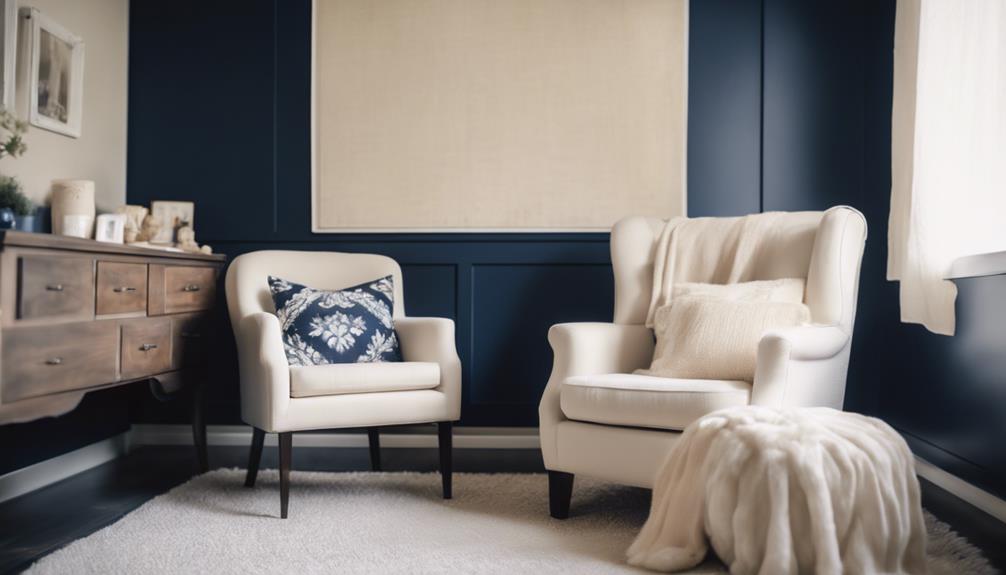
As you start creating a focal point with furniture in your bedroom, consider the three key points to keep in mind: anchoring with a statement piece, balancing with neutrals, and adding a pop of personality.
By incorporating one or more of these elements, you'll be able to draw attention to your navy accent wall and create a visually appealing space.
Anchor With a Statement
You can instantly elevate your navy accent wall by anchoring it with a statement piece of furniture that demands attention. This bold move will create a focal point in the room, drawing the eye towards the accent wall and enhancing the overall aesthetic.
To achieve this, consider the following:
- Choose a furniture piece that complements the navy wall color, such as dark wood tones, metallic accents, or contrasting colors for a cohesive look.
- Select a piece that's proportionate to the accent wall, ensuring a harmonious and visually appealing design.
- Opt for a bold and eye-catching furniture piece that will draw attention to the navy accent wall.
- Consider the scale and proportions of the furniture in relation to the accent wall to achieve a balanced look.
Balance With Neutrals
What's the secret to preventing a navy accent wall from overwhelming your bedroom, and how can you create a stunning focal point with furniture?
The answer lies in balance and harmony. By incorporating neutral furniture pieces into your bedroom design, you can create a beautiful contrast with the bold, dark navy accent wall.
Select neutral-colored furniture, such as a white bed or a light gray dresser, to complement the navy wall. This importance is vital in preventing the room from feeling too dark or overwhelming. Additionally, incorporating light-colored bedding, rugs, or curtains can soften the visual impact of the navy accent wall.
By choosing neutral furniture, you allow the navy accent wall to stand out while maintaining a cohesive and harmonious bedroom design. This balance creates a stunning focal point in the room, drawing the eye to the navy accent wall without overwhelming the senses.
Add a Pop
To elevate your navy accent wall to the next level, introduce a statement piece of furniture that adds a pop of personality to the room. This bold move will create a focal point in your bedroom, drawing the eye towards the accent wall.
But how can you choose the right piece? Here are some tips to keep in mind:
- Opt for a statement headboard in a contrasting color to enhance the navy accent wall even more.
- Select a dresser with an interesting texture or pattern to add depth and visual interest against the navy backdrop.
- Think about a bold, patterned rug to introduce an extra layer of personality to the room.
- Harmonize the boldness of the navy accent wall with carefully chosen furniture pieces that complement the overall aesthetic of the room.
Maintaining a Cohesive Room Aesthetic

As you incorporate a navy accent wall into your bedroom, maintaining a cohesive room aesthetic is crucial to avoid visual discord. You want to create a harmonious space that ties together seamlessly.
To achieve this, make sure that the decor pieces on the navy accent wall complement the existing furniture and color scheme in the room. Consider incorporating matching or coordinating decor elements, such as bedding, throw pillows, or wall art, to uphold a cohesive aesthetic.
Balance the boldness of the navy accent wall with softer or complementary colors in other areas of the room for a harmonious look. Choose accent pieces that enhance the navy wall, such as metallic accents, textured fabrics, or statement decor items that tie the room together.
Frequently Asked Questions
Is Navy Blue a Good Color for a Bedroom?
You're wondering if navy blue is a good color for a bedroom, and the answer is a resounding yes! This timeless hue is known for promoting calmness and relaxation, making it an ideal choice for a bedroom.
Navy blue creates a sophisticated and cozy atmosphere, and its versatility allows it to pair well with a variety of colors, from neutrals to bold accents. It's a great choice to elevate your bedroom's design and ambiance.
How Do I Make My Bedroom Accent Wall Stunning?
You're probably thinking, 'What's the big deal about an accent wall?' But trust us, it's a game-changer.
To make your bedroom accent wall stunning, don't be afraid to think outside the box. Combine navy with unexpected textures and materials, like acoustic panels or natural wood, to add depth and visual interest.
The key is to balance boldness with harmony, so choose complementary colors and patterns that complement your personal style.
How to Do a Navy Blue Accent Wall?
When approaching a navy blue accent wall, you'll need a few essential tools:
- Frogtape
- Behr Paint in Infinite Deep Sea
- A paint roller
- A small paint brush
Guarantee a smooth process by thoroughly taping, cleaning the wall, and spot-checking for missed spots or touch-ups.
Consider alternative designs, like navy blue wallpaper or planked wood, to add a unique twist to your accent wall.
How to Decorate a Bedroom With Navy Blue?
As you consider how to decorate a bedroom with navy blue, remember that this timeless color adds depth and sophistication to the space.
You can incorporate navy blue through bedding, decor items, or an accent wall, which creates a cohesive look.
Pair navy with white, gold, grey, or coral to enhance its impact. By doing so, you'll evoke feelings of calmness and serenity, perfect for a relaxing bedroom atmosphere.
Conclusion
With your navy accent wall in place, you've set the stage for a sophisticated bedroom retreat. By balancing bold navy tones with neutral hues, you've created a harmonious atmosphere.
Now, it's time to layer in textures, patterns, and decorative elements that echo the room's refined aesthetic. As you step back to admire your handiwork, remember that a stunning accent wall is just the beginning – it's the foundation upon which you'll build a cohesive, stylish space that truly reflects your personal style.
Vivienne – Your Content Companion Vivienne is your content companion, curating valuable tips, advice, and inspiration to guide you on your home decor journey. From insightful blog posts to informative product descriptions, she’s here to empower you with the knowledge you need to create your dream space.
Home Decor
How to Implement Sustainable Rural Design in Indonesia
The path to implementing sustainable rural design in Indonesia begins with community engagement, but what innovative strategies can truly make a difference?

To implement sustainable rural design in Indonesia, start by engaging local communities and incorporating their traditional knowledge. Use eco-friendly agricultural practices, like agroforestry and organic farming, to enhance food security and biodiversity. Focus on sustainable water management through rainwater harvesting and community-based initiatives that improve water quality. Foster a multi-actor governance framework that promotes collaboration among stakeholders. This approach not only boosts local economies and job creation but also preserves cultural heritage and environmental health. If you explore further, you'll discover additional strategies and success stories for effective implementation.
Key Takeaways
- Engage local communities through participatory planning to ensure development meets their unique needs and incorporates traditional values.
- Integrate traditional agricultural practices, such as agroforestry and organic farming, to enhance sustainability and food security.
- Implement effective water management strategies, including rainwater harvesting and community-based watershed programs, to conserve water resources.
- Develop sustainable infrastructure that improves market access and connectivity for rural populations, supporting economic resilience.
- Monitor and evaluate initiatives using participatory approaches and measurable indicators aligned with Sustainable Development Goals (SDGs).
Importance of Sustainable Rural Design

Sustainable rural design is vital for preserving Indonesia's unique biodiversity and cultural heritage, as it seamlessly integrates ecological conservation with traditional values. By focusing on sustainable practices, you can foster economic development in rural communities, where agriculture employs around 38.23 million individuals and contributes considerably to the workforce.
This approach not only enhances local economies but also encourages responsible resource management, which is essential for mitigating environmental degradation. Incorporating traditional Indonesian housing styles, such as Rumah Adat, can further enrich sustainable design by promoting the use of local materials and cultural symbolism.
When you prioritize sustainable rural design, you help guarantee that rural communities can withstand the challenges posed by climate change. Improved resilience means that these communities can adapt to environmental shifts while maintaining their livelihoods.
Additionally, engaging local populations in decision-making fosters a sense of ownership and responsibility toward their environment, further strengthening community ties.
In Indonesia, with its rich tapestry of 74,961 villages, embracing sustainable rural design is more than an ecological necessity; it's a means to safeguard traditional values while promoting a sustainable future.
Engaging Local Communities

Community involvement is vital for successful rural design in Indonesia. Engaging local communities helps guarantee sustainable rural development that meets their unique needs. With around 74,961 villages depending on active participation, community-based development frameworks like Integrated Agriculture Development play an essential role in enhancing sustainability.
| Engagement Strategy | Benefits |
|---|---|
| Incorporating Local Culture | Fosters ownership among villagers |
| Strengthening Local Governance | Guarantees community voices are heard |
| Education and Awareness Programs | Empowers communities to contribute |
Using effective engagement strategies is key. Incorporate local culture and traditional practices into design processes to enhance the connection between projects and the community. Strengthening local governance structures facilitates participatory planning, making certain everyone has a say in decision-making.
Moreover, continuous education and awareness programs empower local communities, enabling them to actively contribute to sustainable rural design initiatives. By prioritizing these strategies, you can create a more inclusive environment that promotes community resilience and long-term sustainability. Engaging local communities will ultimately lead to more effective and meaningful rural development outcomes.
Integrating Traditional Knowledge
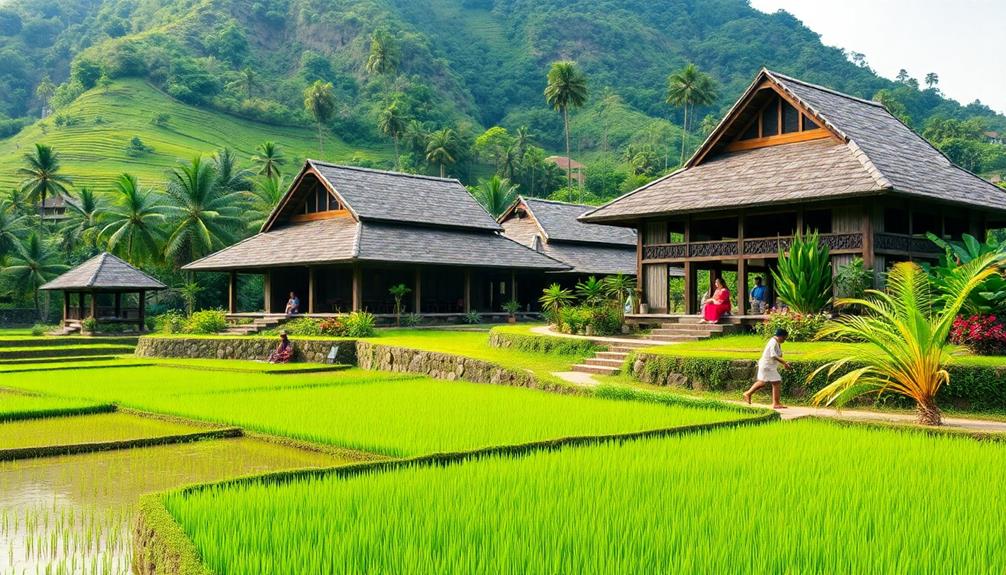
Integrating traditional knowledge into rural design can greatly enhance sustainability in Indonesia. By embracing local agricultural practices, you can help preserve ecosystems while boosting food security for rural communities, where about 70% depend on agriculture.
Traditional knowledge encompasses time-tested methods like agroforestry and rotational farming, which promote soil health and biodiversity. Additionally, implementing elements such as Indonesian decorative pillows can enrich living spaces with cultural heritage while supporting local artisans.
Incorporating these practices into your designs not only fosters sustainable development but also respects the rich cultural heritage of the community. Using local materials and traditional building techniques can markedly reduce the carbon footprint of new developments, creating structures that blend harmoniously with the environment.
Moreover, engaging local communities in the planning process empowers them to maintain and adapt their traditional practices, ensuring that designs reflect their unique needs and values. This community engagement is essential for creating solutions that are both practical and sustainable.
Eco-Friendly Agricultural Practices

Traditional knowledge lays a strong foundation for adopting eco-friendly agricultural practices in Indonesia. By embracing organic farming, you can utilize natural fertilizers and pest control methods, greatly reducing reliance on chemicals and promoting healthier soil.
Additionally, incorporating elements of traditional craftsmanship, such as the use of sustainable materials in farming tools, can further enhance your eco-friendly approach. Agroforestry systems are another great option; they integrate trees with crops, enhancing biodiversity and improving soil fertility, while potentially increasing your income through diverse product offerings.
In rural areas, rainwater harvesting techniques are becoming popular. These methods help conserve water resources, allowing you to collect rainwater for irrigation during dry seasons, ensuring your crops thrive.
Additionally, employing crop rotation and cover cropping can prevent soil erosion and depletion, maintaining nutrient levels and boosting overall agricultural productivity.
Cultural significance of masks can also inspire sustainable design practices that reflect local heritage.
The Indonesian government supports these sustainable practices by offering training programs and financial incentives for farmers who adopt eco-friendly methods. This initiative aims to increase the adoption rate of these practices nationwide.
Sustainable Water Management

Sustainable water management is fundamental for preserving Indonesia's rich water resources, which include over 5,000 rivers and countless lakes essential for local ecosystems and agriculture.
With about 70% of Indonesia's freshwater sourced from rainfall, effective rainwater harvesting and storage systems are crucial to address seasonal shortages. Traditional housing designs often incorporate features to manage water runoff effectively, showcasing a harmonious relationship between architecture and the environment traditional housing designs.
By implementing integrated water resource management (IWRM) practices, you can enhance water quality and availability, tackling pollution that threatens both human health and biodiversity.
Community-based initiatives, like local watershed management programs, empower rural populations to adopt sustainable practices and secure equitable access to water resources. These initiatives not only foster cooperation among community members but also strengthen rural economic resilience by promoting responsible water use.
Government policies, such as the National Water Resources Law (Law No. 17/2019), underscore the importance of sustainable water management to support agricultural productivity while protecting environmental and community interests.
Infrastructure Development Strategies

To effectively transform rural Indonesia, infrastructure development strategies must focus on creating sustainable roads and transportation networks that enhance access to markets and services. By prioritizing these sustainable roads, you'll improve connectivity for over 38 million individuals engaged in agriculture, enabling better access to essential services and markets.
Incorporating elements of luxury tropical design aesthetics can also inspire innovative community spaces that promote local culture and well-being. Integrating renewable energy solutions, like solar power, into your infrastructure projects can boost energy access while reducing reliance on fossil fuels. This step is significant for guaranteeing a sustainable future in rural areas.
Additionally, investing in water management systems and irrigation infrastructure is critical. It supports agricultural productivity and guarantees the efficient use of Indonesia's abundant water resources, which are significant for rural economies.
You should also consider establishing Village-Owned Enterprises (BUMDes) as they can drive local economic growth. These enterprises can create infrastructure that supports community-based development projects, enhancing self-sufficiency.
Moreover, emphasizing community participation during the planning and implementation phases guarantees that infrastructure projects align with local needs, making them more sustainable and culturally appropriate. By focusing on these strategies, you can lay the groundwork for a thriving, resilient rural Indonesia.
Multi-Actor Governance Framework

In Indonesia, multi-actor governance relies on collaborative decision-making processes that bring together diverse stakeholders.
This approach mirrors the intricate artistry found in traditional Indonesian decor masks, which often reflect the rich cultural narratives and community values.
You'll find that engaging local communities, NGOs, and the private sector not only fosters transparency but also enhances the effectiveness of rural development strategies.
Collaborative Decision-Making Processes
A robust multi-actor governance framework greatly enhances collaborative decision-making processes in sustainable rural design initiatives across Indonesia. By bringing together government agencies, local communities, NGOs, and the private sector, this approach guarantees that diverse perspectives are included.
Incorporating local cultural elements, such as Indonesian wedding decor ideas, into the planning process can enrich community engagement and foster a sense of ownership among participants. Participatory approaches play a significant role in integrating local knowledge and cultural values, making sustainable rural development more relevant and accepted.
When you foster effective multi-actor governance, you promote transparency and legitimacy in decision-making. This is especially important for marginalized communities, whose voices often go unheard. Establishing trust among stakeholders is essential; ongoing dialogue, shared goals, and mutual benefits can facilitate this trust-building process.
Moreover, successful collaborative decision-making leads to improved resilience and sustainability of rural projects. By facilitating resource sharing and coordinated action, you can optimize the use of available resources, guaranteeing that all stakeholders work towards common objectives effectively.
As you engage multiple actors, you not only enhance the quality of decisions but also empower local communities to take an active role in shaping their futures. Ultimately, this collaborative approach is key to achieving sustainable rural development in Indonesia.
Stakeholder Engagement Strategies
Engaging stakeholders effectively is essential in the multi-actor governance framework for sustainable rural design. By involving diverse community groups, local government, NGOs, and private sector actors, you enhance legitimacy and transparency. Implementing participatory planning processes empowers local communities to express their needs and preferences, ensuring that initiatives align with their cultural contexts.
Here's a simple table outlining effective strategies for stakeholder engagement:
| Strategy | Description |
|---|---|
| Participatory Planning | Engaging communities in the decision-making process. |
| Regular Meetings | Facilitating ongoing communication and updates. |
| Resource Sharing | Promoting collaboration for mutual benefits. |
| Trust Building | Utilizing informal networks to foster relationships. |
| Local Knowledge Integration | Leveraging community expertise for project relevance. |
Economic Benefits of Sustainability

Sustainable rural design in Indonesia creates increased local employment opportunities, directly impacting community economic resilience.
By adopting sustainable resource management practices, such as utilizing natural materials and promoting eco-friendly construction, you can help communities thrive while protecting their environment.
This approach not only boosts local economies but also guarantees a stable future for generations to come.
Increased Local Employment Opportunities
Creating local employment opportunities is an essential aspect of sustainable rural design in Indonesia. By focusing on eco-friendly agriculture, you can tap into an industry that employs around 38.23 million individuals, representing nearly 30% of the total workforce. This creates a strong foundation for economic growth and stability.
Incorporating elements of traditional Indonesian style home decor can also enhance local craftsmanship and provide job opportunities in art and design. Implementing community-based tourism initiatives will attract visitors, generating jobs and creating an economic multiplier effect that bolsters local businesses.
Investing in sustainable infrastructure, such as improved roads and irrigation systems, enhances access to markets, further increasing local employment opportunities. Additionally, renewable energy projects like solar farming not only provide jobs but also reduce reliance on non-renewable resources, promoting both economic and environmental sustainability.
Moreover, promoting Village-Owned Enterprises (BUMDes) empowers communities to create jobs locally. These enterprises are designed to enhance economic self-sufficiency, allowing for various sustainable ventures that benefit the entire community.
Enhanced Community Economic Resilience
Fostering local employment opportunities directly contributes to enhancing community economic resilience in rural Indonesia. By embracing sustainable practices, villages can markedly boost their local economies and provide better livelihoods for their residents.
This approach can also benefit from cultural elements, such as incorporating local traditions into community events, which can enhance Indonesian party decorations.
Here's how you can experience these benefits:
- Job Creation: Sustainable agriculture and eco-tourism generate new economic activities, employing local talent.
- Increased Income: Implementing sustainable practices can lead to a 10-20% rise in local income, which helps reduce poverty.
- Community-based Development: Focusing on local resources enhances food security and self-sufficiency, reducing reliance on external markets.
- Tourism Revenue: Prioritizing sustainability can attract more visitors, increasing tourism revenue by 15-30%, which can be reinvested into local initiatives.
Sustainable Resource Management Practices
When you think about the economic benefits of sustainability in rural Indonesia, sustainable resource management practices stand out as a powerful tool for enhancing livelihoods. By adopting methods like agroforestry and organic farming, farmers can boost their income by up to 30% compared to conventional practices. This increase plays a crucial role in fostering economic growth in rural areas.
Additionally, community-based fisheries management (CBFM) has shown remarkable results, improving fish stocks by 20-50%. This not only sustains fish populations but also secures better livelihoods for local fishing communities.
Eco-friendly tourism initiatives can further enhance the economy, generating up to 15% more revenue while preserving local culture and the environment.
Utilizing renewable energy sources, such as solar and biogas, offers another way to manage resources sustainably. These solutions can reduce energy costs by around 40%, providing significant economic savings for local communities.
Furthermore, engaging these communities in sustainable land management practices has been linked to a 25% reduction in soil erosion, which helps maintain agricultural productivity and strengthens ecosystem resilience.
Embracing these practices is essential for a prosperous and sustainable future in rural Indonesia.
Monitoring and Evaluation Techniques
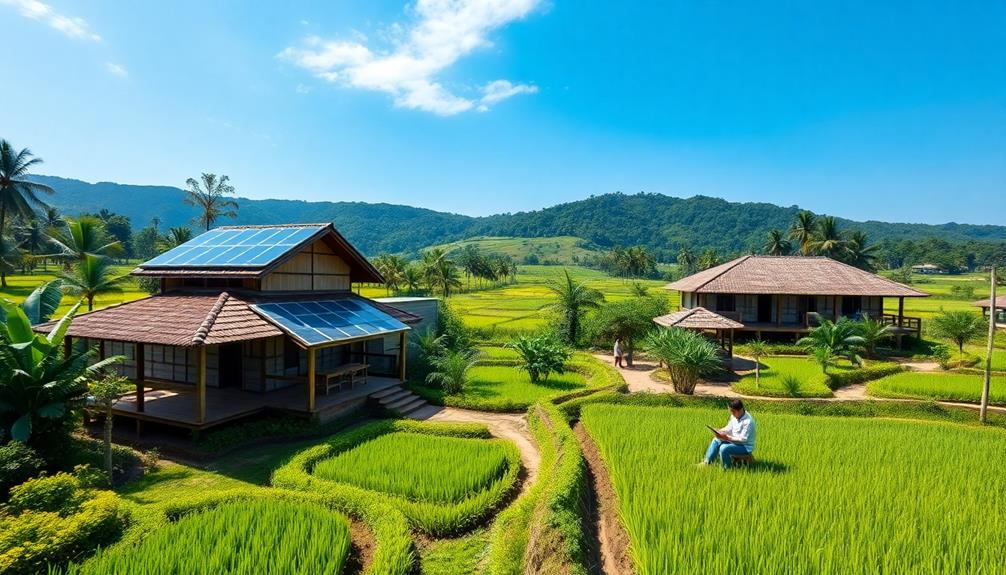
Effective monitoring and evaluation (M&E) techniques play an essential role in ensuring the success of sustainable rural design in Indonesia.
To effectively assess the progress of your initiatives, you should focus on several key strategies:
- Set clear measurable indicators aligned with the Sustainable Development Goals (SDGs).
- Utilize participatory approaches to involve local communities in the evaluation process.
- Collect regular community feedback through surveys and other mechanisms.
- Leverage Geographic Information Systems (GIS) for spatial data analysis.
Case Studies in Indonesia
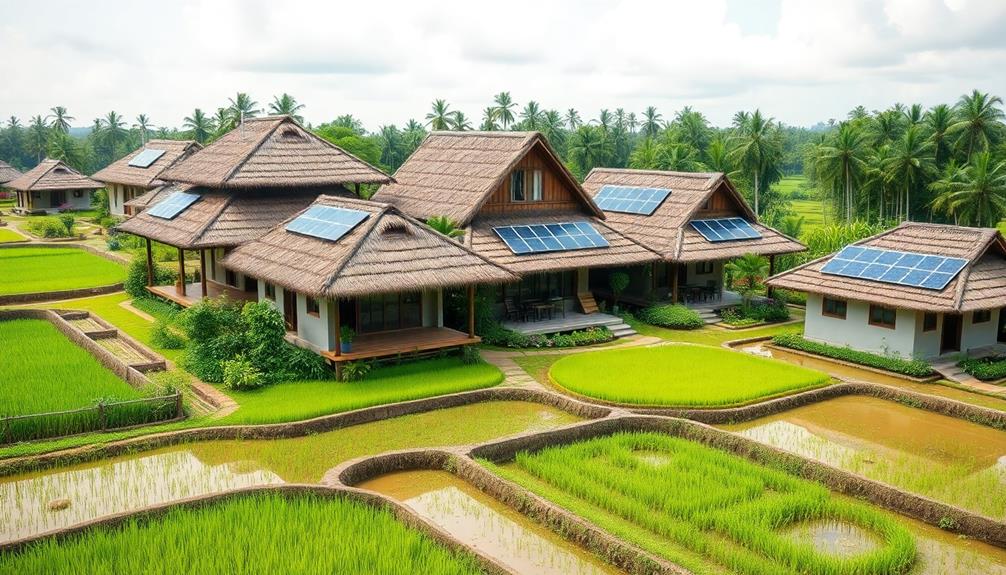
Numerous case studies in Indonesia showcase the impactful results of sustainable rural design through community-driven initiatives. For instance, the Integrated Agriculture Development (IAD) program enhances local food production while preserving biodiversity, demonstrating how community-based initiatives can address food security.
The Community-Based Forest Management (CBFM) initiative has empowered local communities to manage forest resources sustainably, leading to a remarkable 20% increase in forest cover over five years.
In coastal areas, the Ecosystem Approach to Fisheries Management (EAFM) has considerably improved fish stocks and local livelihoods, with a 30% rise in fishery yields since its implementation.
These examples highlight how rural development projects, supported by the Village Fund Program, foster local infrastructure and community empowerment. Established by Law No. 6 of 2014, this program has provided over IDR 70 trillion (approximately USD 5 billion) to support these initiatives.
Moreover, successful case studies underline the importance of participatory planning. When local stakeholders actively engage in decision-making, more than 80% report increased satisfaction with rural development outcomes.
This engagement is critical for achieving lasting impacts in sustainable rural design in Indonesia.
Frequently Asked Questions
What Sustainability Strategies Have Been Implemented in Indonesia?
Indonesia's implemented sustainability strategies include the Village Fund Program for community projects, Integrated Agriculture Development for eco-friendly farming, Community-Based Forest Management for resource stewardship, and Ecosystem Approach to Fisheries Management for protecting marine biodiversity and supporting livelihoods.
How Can We Make Sustainable Rural Communities?
"You reap what you sow." To create sustainable rural communities, engage locals in decision-making, blend traditional knowledge with modern practices, support entrepreneurship, and provide ongoing training. This guarantees resilience and long-term benefits for everyone involved.
How Can Sustainable Development Be Improved in Rural Areas?
You can improve sustainable development in rural areas by engaging communities actively, adopting community-based frameworks, strengthening governance, securing financial strategies, and continuously evaluating practices to fit unique cultural and environmental contexts.
Conclusion
In embracing sustainable rural design in Indonesia, you're planting seeds of hope for vibrant communities and flourishing ecosystems. By weaving together local voices, traditional wisdom, and green practices, you're not just building structures; you're nurturing a tapestry of resilience. As you cultivate these initiatives, you'll see the fruits of your labor—economic growth, strengthened ties, and a thriving environment. Let this journey be a gentle breeze that carries you and the communities towards a sustainable and prosperous future.
Home Decor
Embracing Sustainable Rural Design in Indonesia
Discover how Indonesia’s sustainable rural design intertwines culture and ecology, paving the way for vibrant communities—what innovative practices are emerging next?
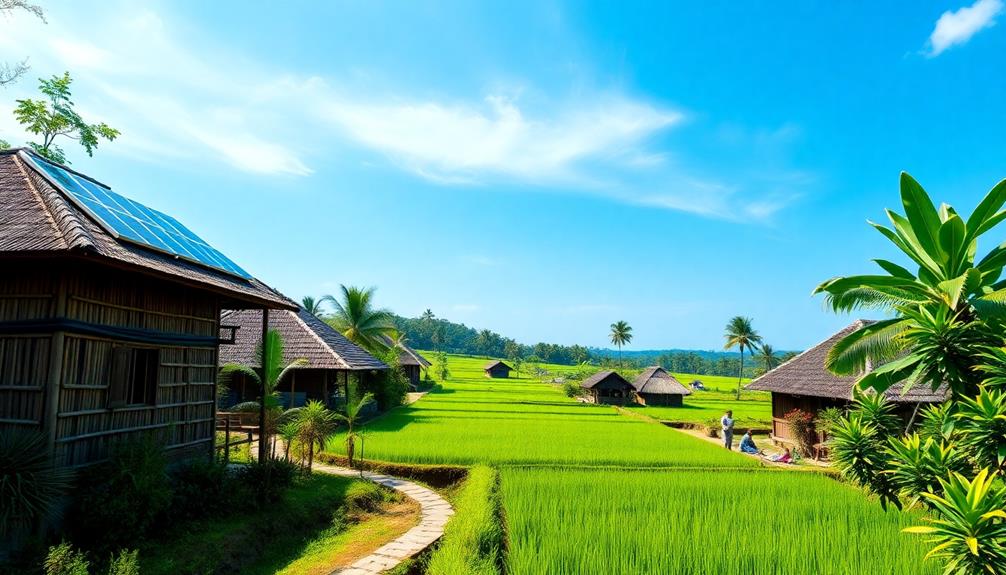
Embracing sustainable rural design in Indonesia involves blending local culture with ecological practices for vibrant communities. You'll see initiatives that prioritize community involvement and leverage Traditional Ecological Knowledge for sustainable agriculture. Local materials reflect rich traditions, while participatory design methods build resilience and social unity. Economic benefits flourish through responsible forestry and crop diversification, increasing household income and improving market access. By managing protected forests, locals enhance biodiversity and conserve essential resources. This approach not only supports environmental health but also aims for future tourism and rural empowerment. There's much more to explore about these inspiring practices and their impacts.
Key Takeaways
- Sustainable rural design in Indonesia integrates local materials and traditional housing styles to reflect cultural identity and ecological preservation.
- Community engagement is essential, allowing residents to participate in decision-making processes that shape their environment and foster social cohesion.
- Utilizing Traditional Ecological Knowledge (TEK) enhances sustainable agricultural practices, promoting biodiversity and resilience in rural communities.
- Community-based forestry management empowers households, increases income through diverse crops, and improves local water supply while conserving forest resources.
- Future goals focus on eco-tourism development and collaboration with government bodies to establish replicable models for sustainable resource management.
Overview of Sustainable Rural Design

Sustainable rural design in Indonesia plays an essential role in balancing ecological preservation with local cultural identities. This approach emphasizes community engagement, ensuring that residents actively participate in shaping their environment.
By integrating Traditional Ecological Knowledge (TEK), practices like Niteni highlight the importance of observing natural phenomena to promote sustainable agriculture, fostering both ecological balance and regional identity. Additionally, the integration of local materials in construction can reflect traditional Indonesian housing, further enriching the cultural significance of sustainable design.
Participatory design methods encourage you to become co-designers in your community, creating innovative solutions that enhance resilience and social cohesion. These methods help develop sustainable rural designs that not only protect biodiversity but also strengthen local economies.
Job creation in sectors like hospitality and agriculture results from these efforts, contributing to the local GDP while ensuring equitable access to land rights and resources.
Successful examples, such as Taba Padang village, demonstrate the effectiveness of sustainable rural design in improving livelihoods through community-based forestry management. By harnessing eco-tourism opportunities, these initiatives help protect biodiversity while simultaneously enhancing the quality of life for residents.
Ultimately, embracing sustainable rural design means investing in a future where ecological preservation and cultural heritage thrive together.
Community-Based Forestry Management

In the heart of Taba Padang village, community-based forestry management has transformed the way residents interact with their environment. This initiative allows 470 households to manage 1.5 hectares of protected forest each, promoting sustainable agriculture and biodiversity conservation.
With an emphasis on integrating traditional practices, local artisans also contribute by creating Indonesian decorative pillows that reflect cultural heritage, adding a touch of vibrancy to the community's living spaces. Spearheaded by village chief Yoyon, it took nearly four years to secure permits, prohibiting land clearing for plantations while allowing crops to thrive in the understory.
Since implementing this model, farmers have reported significant income increases through the cultivation of coffee, pepper, durian, and rattan. Additionally, they've enjoyed improved water supply from forest farms, which is essential for rural development.
Regular inspections by officials every five years guarantee adherence to conservation practices, reflecting the community's commitment to forest protection and sustainable land use.
Taba Padang's success has garnered recognition from the Indonesian Ministry of Environment and Forestry, showcasing a balanced approach to economic growth and environmental conservation.
Economic and Social Benefits
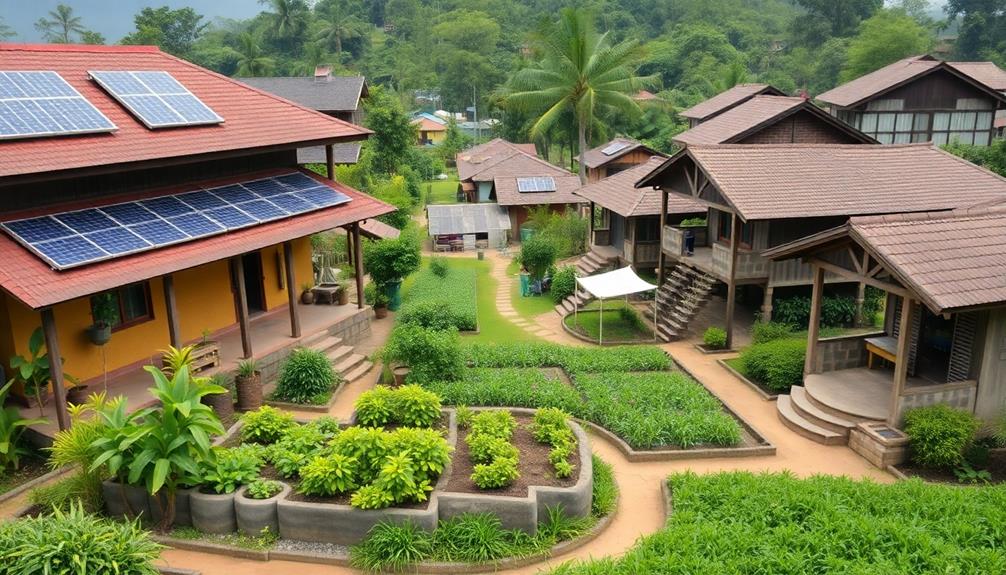
The implementation of community-based forestry management in Taba Padang village has brought tangible economic and social benefits to its residents. By focusing on sustainable farming practices, 470 households have experienced significant income increases through the cultivation of coffee, pepper, durian, and rattan. This economic upliftment has been further enhanced by improved transportation, as motorbikes now enable farmers to efficiently transport their harvests to markets.
Furthermore, the use of local materials in housing can potentially complement these agricultural practices, creating a holistic approach to rural development.
Additionally, the effective management of forest resources has led to an improved water supply, which has positively impacted agricultural productivity and the overall quality of life within the community. The recognition from the Indonesian Ministry of Environment and Forestry not only validates these local efforts but also opens doors for eco-tourism, presenting new opportunities for rural development.
As community members engage in sustainable practices, they feel more empowered, reducing anxiety over legal repercussions related to farming in protected areas. This shift fosters a sense of local governance, allowing residents to take charge of their resources and future.
Essentially, the economic and social benefits of community-based forestry in Taba Padang create a more resilient and thriving community.
Environmental Conservation Strategies

Shifting from deforestation to a focus on reforestation and conservation has transformed Taba Padang village into a model of environmental stewardship. By recognizing forest conservation as crucial for community livelihoods, you can see how sustainable practices thrive here. With each household managing 1.5 hectares in a protected forest, land clearing for plantations is prohibited, allowing for the cultivation of diversified crops in the understory, which helps maintain ecological balance.
Here's a snapshot of the environmental conservation strategies being employed:
| Strategy | Description |
|---|---|
| Protected Forest | 9.95 square kilometers managed by local farmers |
| Crop Diversification | Coffee, pepper, durian, and rattan cultivated |
| Regular Inspections | Conducted every five years for compliance |
| Biodiversity Promotion | Conservation of rare species like Hornstedtia rubra |
| Community Engagement | Fostering involvement in wildlife protection |
These initiatives not only enhance biodiversity but also play a significant role in rural development. The village's commitment to environmental conservation shows that preserving nature can lead to thriving community livelihoods and a sustainable future.
Future Aspirations and Goals
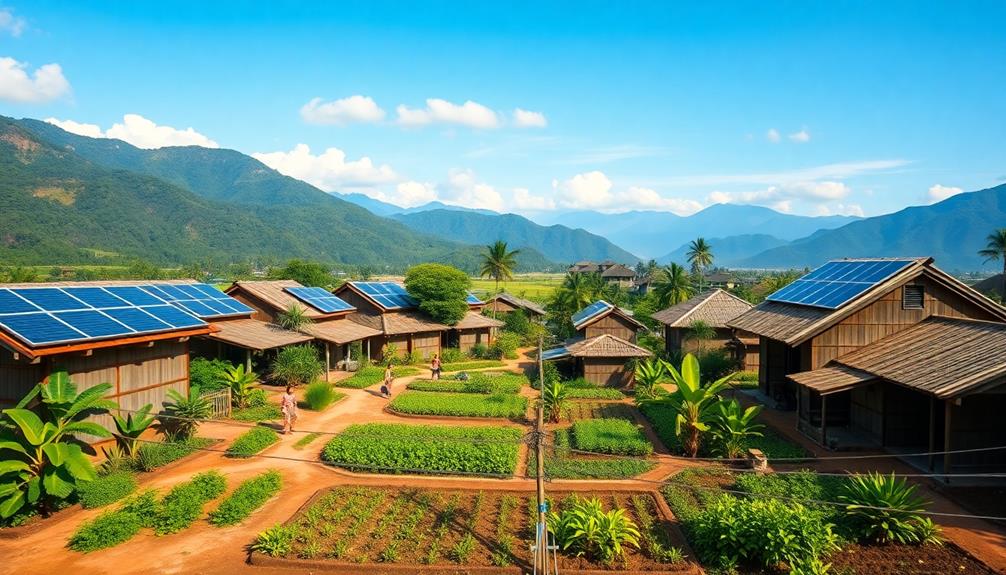
As Taba Padang village looks to the future, it's determined to enhance local welfare while preserving its precious forest resources. The community's commitment to sustainable development is evident as they actively engage in conservation efforts, ensuring the sustainable management of their forested areas.
By prioritizing forest conservation, you're not just protecting the environment; you're improving the quality of life for everyone in the village. This commitment aligns with principles found in tropical architecture, which emphasizes harmony with the natural surroundings.
Local tourism is a key focus, with aspirations to attract visitors to natural attractions like waterfalls and hot springs. This approach can boost the village's economy and create job opportunities, benefiting local communities.
You'll see that the integration of community-based forestry management is essential, as it empowers residents to take charge of their natural resources. Collaborating with government bodies will also play a significant role in refining these sustainable practices.
Taba Padang aims to serve as a replicable model for other Indonesian villages, demonstrating effective natural resource management and sustainable development. By embracing these goals, you're not just enhancing local welfare today; you're ensuring a sustainable and prosperous future for generations to come.
Frequently Asked Questions
What Sustainability Strategies Have Been Implemented in Indonesia?
In Indonesia, you'll find strategies like community-managed forests, diverse crop cultivation, and regular inspections promoting sustainable practices. By integrating Traditional Ecological Knowledge, locals engage in participatory designs, enhancing resilience and sustainable development in their communities.
What Is the Indonesia Sustainable Landscapes Management Program?
The Indonesia Sustainable Landscapes Management Program focuses on improving livelihoods through sustainable forest management. You'll engage with communities, governments, and the private sector to address deforestation, enhance food security, and guarantee equitable land access.
How Can We Make Sustainable Rural Communities?
You know the saying, "Many hands make light work." To create sustainable rural communities, engage locals in decision-making, utilize traditional knowledge, diversify economies, and foster collaboration, ensuring everyone's voice contributes to a thriving, resilient future.
Why Is Sustainability Important in the Rural Areas?
Sustainability's essential in rural areas because it preserves biodiversity, enhances local livelihoods, and strengthens community ties. By adopting sustainable practices, you're not only protecting the environment but also fostering economic resilience and social cohesion for future generations.
Conclusion
In embracing sustainable rural design, you're not just enhancing the environment; you're fostering vibrant communities. Did you know that Indonesia's community-based forestry management has led to a 30% increase in local incomes? By prioritizing eco-friendly practices, you're contributing to a healthier planet and empowering local economies. As you look to the future, keep pushing for innovative strategies that balance economic growth with environmental stewardship. Together, you can make a lasting difference for generations to come.
Home Decor
Top Sustainable Rural Design Trends in Indonesia
Keen to discover how Indonesia blends tradition with innovation in rural design? Uncover the trends reshaping sustainable living and community resilience.
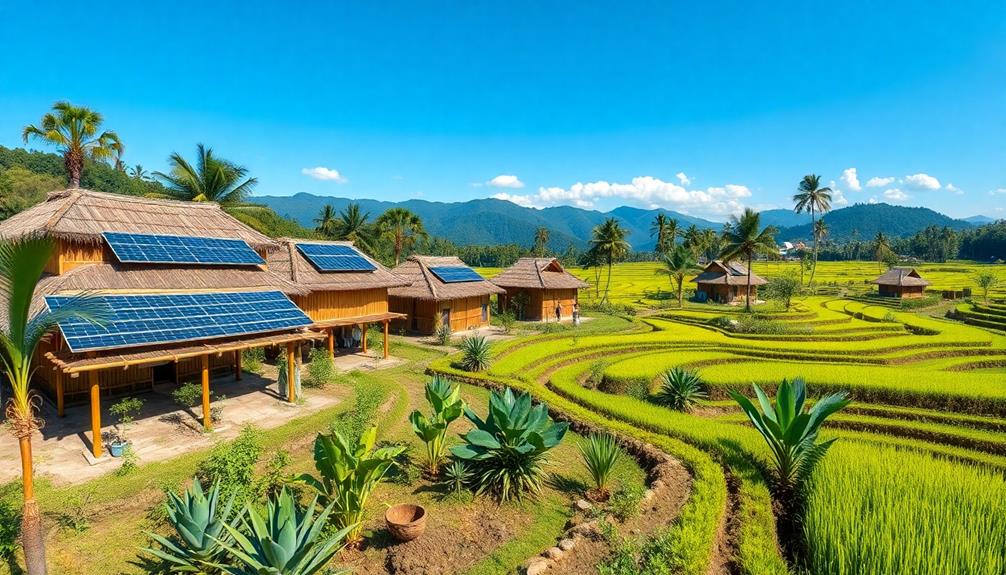
Top sustainable rural design trends in Indonesia focus on preserving cultural heritage while promoting ecological integrity. You'll see participatory design approaches that engage locals, ensuring their voices shape development. Traditional Ecological Knowledge, like Niteni and Pranatamangsa, enhances agricultural practices and fosters community ties. Community engagement strategies empower local craftsmanship and strengthen identities. Additionally, the Smart Villages concept utilizes technology to improve living conditions and promote entrepreneurship. These trends not only enhance resilience but also connect people to nature. If you're curious about how these elements come together for a sustainable future, there's much more to explore.
Key Takeaways
- Participatory design approaches empower communities by involving locals in the design process, ensuring their needs and cultural identities are prioritized.
- Traditional Ecological Knowledge (TEK) supports sustainable agriculture, utilizing techniques like Niteni and Pranatamangsa to enhance crop yields and biodiversity.
- Community engagement strategies promote local craftsmanship and traditions, strengthening community identity and fostering pride in cultural heritage.
- The Smart Villages concept utilizes ICT to enhance living conditions, promote local entrepreneurship, and support environmental stewardship in rural areas.
- Future directions focus on integrating TEK with luxury tropical design aesthetics, maintaining a connection to nature while promoting sustainable practices.
Impact of Industrialization on Rural Areas

Industrialization in Indonesia has profoundly impacted rural areas, reshaping lives and landscapes alike. As you observe the shift from traditional farming to modern agricultural practices, you'll notice the erosion of cultural identities tied to these age-old methods.
The Green Revolution of 1968 marked a turning point, prioritizing economic growth over sustainable development, leading to significant environmental degradation and a loss of biodiversity. This transformation has also influenced traditional housing designs, as many rural communities are adapting to modern materials and construction methods, often at the expense of their cultural heritage and sustainability principles.
Traditional Indonesian houses typically utilize natural materials that promote sustainability, a practice that's increasingly overlooked in favor of contemporary building techniques.
Urbanization policies have exacerbated the economic divide, leaving rural poverty rates at 12.36% as of September 2022. This uneven development has disrupted not only local economies but also the community ties that once flourished around farming.
Mechanized practices have taken precedence, focusing on profit rather than ecological sustainability, which further contributes to the decline of traditional farming.
As you witness these changes, it becomes clear that the need for sustainable rural development in Indonesia is critical. By integrating traditional ecological knowledge into modern practices, you can help revitalize rural communities and preserve their cultural heritage amidst the pressures of industrialization.
Embracing sustainable design practices can pave the way for a more balanced approach that honors both economic growth and the environment.
Participatory Design Approaches
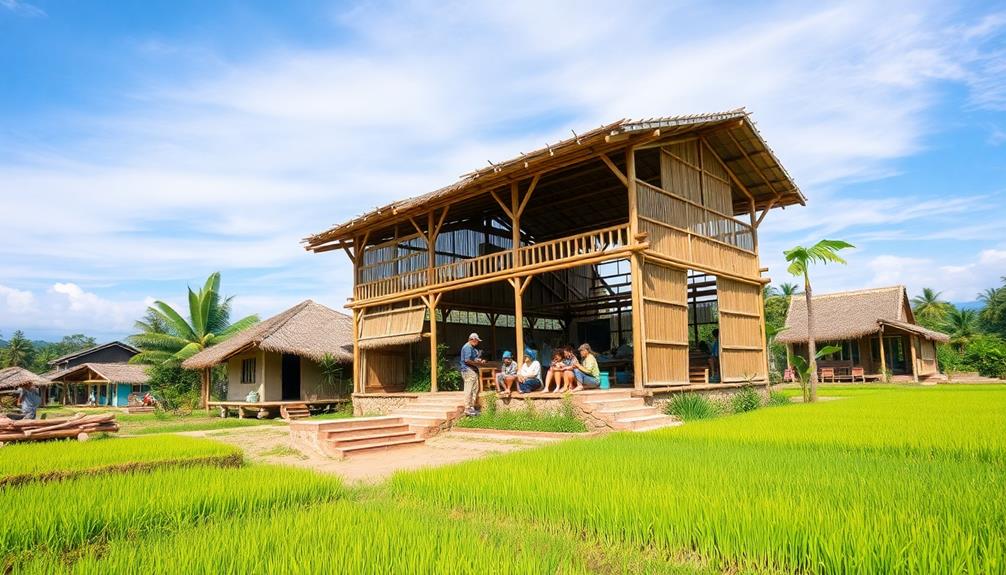
As rural communities in Indonesia face the challenges of modernization, participatory design approaches offer a solution that empowers locals by involving them directly in the design process. By treating community members as active contributors rather than passive subjects, you enhance local ownership and guarantee that projects are relevant to their needs.
This is particularly important in regions where traditional housing styles, such as Rumah Adat, reflect cultural significance and social status, emphasizing the need for designs that resonate with local identities.
The participatory design process includes activities like initiation meetings, treasure mapping, and idea generation workshops. These methods help identify community assets and guarantee all voices are heard. Engaging diverse stakeholders—such as local farmers and government representatives—fosters collaborative engagement to tackle local development challenges and promotes resilience in rural communities.
Additionally, utilizing ethnographic methods allows you to document local cultural practices, guaranteeing designs are informed by the unique context of the area. This approach supports sustainable development by integrating Traditional Ecological Knowledge, which enhances agricultural practices and strengthens regional identity.
Ultimately, participatory design not only addresses immediate needs but also nurtures a sense of community empowerment, setting a foundation for long-term ecological balance and sustainable growth in rural Indonesia.
Traditional Ecological Knowledge

In Indonesia, you'll find that Traditional Ecological Knowledge (TEK) plays a crucial role in sustainable agriculture through techniques like Niteni, which encourages careful observation of nature.
This approach aligns well with the use of natural materials in various aspects of Indonesian life, such as in Indonesian Kitchen Decor, where bamboo and wood enhance functionality and beauty.
By following the Pranatamangsa seasonal guidelines, farmers can align their practices with natural cycles, ensuring healthier crops.
Embracing TEK not only promotes environmental balance but also strengthens community ties and regional identity.
Niteni Observation Techniques
While many modern agricultural techniques focus on technology, Niteni observation techniques rooted in traditional ecological knowledge offer invaluable insights for sustainable farming in Indonesia. By engaging in Niteni, you can closely observe and document natural phenomena, allowing you to understand seasonal changes and ecological patterns that influence your farming practices.
This approach is essential for making informed decisions about when to plant and harvest, as guided by the Pranatamangsa calendar. Additionally, integrating elements of local culture, such as unique artistic expressions reflected in traditional crafts, can enhance community engagement and pride.
Niteni emphasizes the interconnection between human activities and nature, promoting sustainable living and ecological balance in rural areas in Indonesia. As you incorporate Niteni into your agricultural practices, you not only enhance your regional identity and local pride but also foster community engagement and empowerment.
This participatory design process supports the preservation of cultural heritage and biodiversity, key factors for sustainable development.
Utilizing Niteni in your farming methods can create a more resilient agricultural system that respects local traditions while adapting to modern challenges. By embracing these traditional observation techniques, you contribute to a sustainable future that honors both your community and the environment.
Pranatamangsa Seasonal Guidelines
Building on the insights gained from Niteni observation techniques, the Pranatamangsa seasonal guidelines offer a structured approach to agricultural timing in Indonesia. This traditional ecological knowledge system helps you optimize your agricultural activities by aligning planting and harvesting times with natural indicators.
By observing local weather patterns, moon phases, and ecological changes, you can enhance crop yields and better manage your resources. This approach resonates with the principles of Balinese design characteristics, which emphasize sustainability and a connection to nature.
Incorporating Pranatamangsa into your farming practices not only supports sustainable development but also reinforces the cultural identity of rural Indonesia. This deep-rooted wisdom enables you to mitigate the risks of crop failure, promoting food security and environmental stewardship within your community.
As you embrace these seasonal guidelines, you contribute to the preservation of local ecosystems and biodiversity. Utilizing Pranatamangsa reflects the importance of traditional design in modern agriculture, reminding you that sustainable practices are rooted in respecting nature.
Community Engagement Strategies

When you engage with rural communities in Indonesia, using collaborative design approaches can notably enhance the outcome.
By integrating local knowledge, such as traditional craftsmanship and cultural symbols, you not only respect their traditions but also empower them to participate actively in the design process.
This aligns with the principles of Indonesian wedding decor ideas, fostering sustainable practices that resonate with the community's values and needs.
Collaborative Design Approaches
Engaging communities in the design process is essential for fostering sustainable rural development in Indonesia. By utilizing collaborative design approaches, you can guarantee that all community members participate in decision-making, leading to impactful social innovation. Participatory learning techniques, like initiation meetings and craft design workshops, actively involve stakeholders, making them co-creators of their environment.
Incorporating Traditional Ecological Knowledge (TEK) enriches the design by preserving local narratives and identities. Recently, a project included 58 participants—24 from the local community and 28 from outside—highlighting the significance of diverse stakeholder collaboration for effective rural development.
Here's a quick look at key aspects of collaborative design approaches:
| Aspect | Description |
|---|---|
| Participatory Learning | Engaging community in decision-making processes |
| Multi-Sector Collaboration | Involving diverse stakeholders for effective solutions |
| Social Innovation | Creating sustainable and innovative community-led projects |
Focusing on openness and connectedness encourages knowledge exchange, addressing local challenges through a holistic approach. By embracing these strategies, you're not just designing spaces; you're empowering communities to shape their futures sustainably.
Local Knowledge Integration
Integrating local knowledge into the design process greatly enhances community engagement strategies in rural Indonesia. By utilizing local knowledge integration, you tap into the rich resources of Traditional Ecological Knowledge (TEK), which fosters sustainable development. Engaging local stakeholders through participatory design allows you to create solutions that resonate with community values and needs.
Additionally, incorporating elements such as traditional artistry into your designs can further enrich the cultural significance of the projects.
In your approach, consider using ethnographic methods to document community life. This helps capture local perspectives that inform your design decisions, reinforcing cultural narratives and ensuring that your initiatives reflect the community's identity.
Activities like treasure mapping and craft design workshops encourage community empowerment, giving locals a sense of ownership over development projects.
Collaborative engagement with diverse stakeholders, including local farmers and government representatives, is essential for addressing local development challenges. By actively involving these groups in the design process, you promote social innovation that benefits everyone.
Case Study: Sabrang Village

Sabrang Village, nestled in Delanggu District, serves as a compelling example of sustainable rural design in Indonesia. This village is renowned for its rice production, yielding around 20,395 tons annually, thanks to the cultivation of local varieties like Rojolele and Mentik Wangi.
The community's commitment to sustainable development is evident through its participatory design practices, which engage 58 participants, including local farmers and external stakeholders. This collaboration fosters community involvement, ensuring that everyone has a voice in shaping their environment.
Moreover, the use of traditional Indonesian style home decor within village structures enhances the cultural significance and aesthetic appeal of the community.
Traditional Ecological Knowledge (TEK) plays an essential role in Sabrang's agricultural practices. Techniques like Niteni and Pranatamangsa guide farmers in observing natural phenomena and adhering to seasonal farming guidelines.
The village emphasizes traditional design that reflects local cultural values and craftsmanship, inspired by Japanese design traditions. This approach not only enhances identity-making but also strengthens community-building efforts.
Sabrang's focus on co-creation and participatory learning is key to enhancing the resilience of its agricultural practices and overall community life. By integrating these elements, Sabrang Village exemplifies how sustainable rural design can effectively harmonize cultural heritage with modern agricultural needs.
Smart Villages Concept
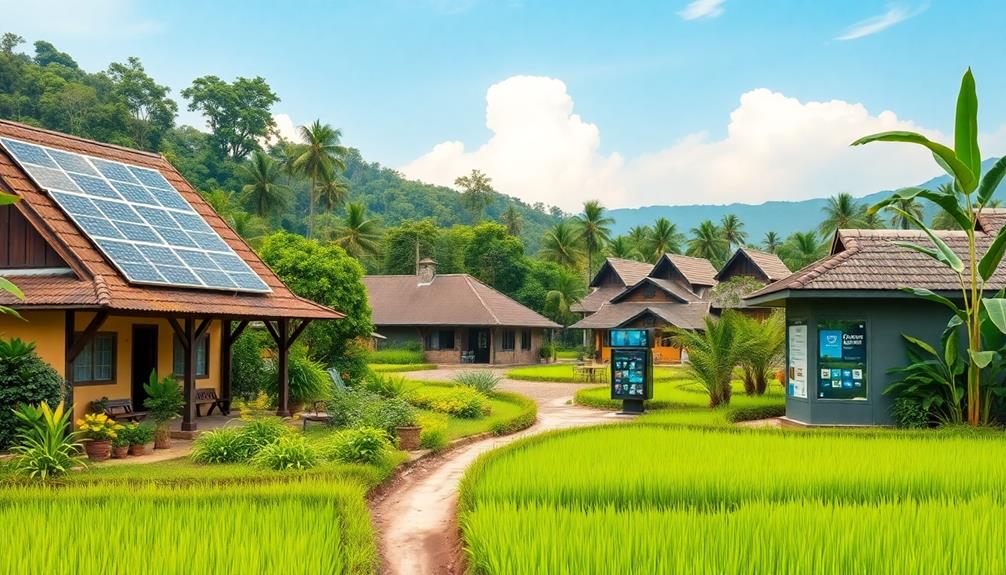
How can the Smart Villages concept transform rural life in Indonesia? By leveraging information and communication technology (ICT), Smart Villages enhance community resilience and promote sustainable development. This approach addresses vulnerabilities and improves local living conditions, fostering social inclusion and collective well-being.
| Key Elements | Benefits | Examples |
|---|---|---|
| ICT Integration | Improved access to services | Pondok Ranji for education |
| Local Entrepreneurship | Economic growth | Geluran Taman for language skills |
| Community Collaboration | Tailored solutions | Stakeholder engagement |
| Sustainable Practices | Environmental stewardship | Renewable energy initiatives |
The COVID-19 pandemic highlighted the need for Smart Villages, emphasizing their role in sustainable national development. As of 2022, 8.43% of villages were classified as Independent, while 27.34% were Developed, illustrating ongoing efforts to bridge rural disparities. Successful implementations demonstrate innovative strategies that attract investment and empower local entrepreneurs. By prioritizing community characteristics and input, Smart Villages can effectively meet local needs, fostering a resilient and inclusive rural environment. This transformation not only enhances living conditions but also paves the way for a brighter future for rural Indonesia.
Future Directions in Rural Design
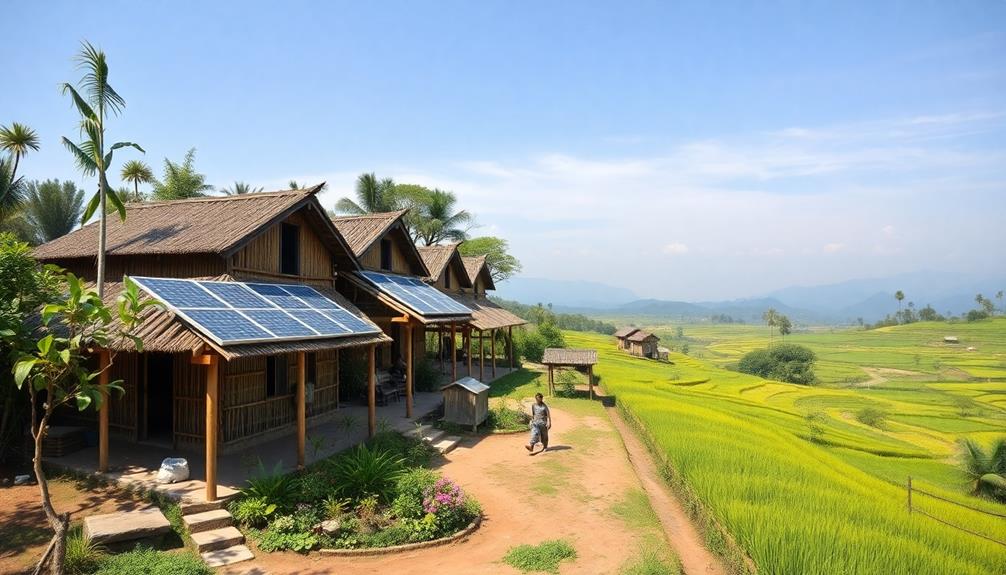
Embracing innovative approaches, future rural design in Indonesia is set to harness Traditional Ecological Knowledge (TEK) and smart village concepts to create sustainable environments.
By integrating TEK, you'll promote sustainable agricultural practices and enhance local biodiversity, drawing inspiration from methods like Niteni and Pranatamangsa, which emphasize observing nature. Additionally, incorporating elements from luxury tropical design aesthetics can enhance the visual appeal of rural spaces while maintaining a connection to the natural environment.
As you engage in community-focused design, participatory approaches will allow you to shape social landscapes, fostering a strong local identity and empowering residents. By prioritizing the community's input, you'll create spaces that resonate with their values and needs.
Moreover, the shift toward smart villages will leverage technology, enhancing local economies and resilience. With robust information and communication technology (ICT) infrastructure, rural areas can access improved education, health services, and economic opportunities.
This digital transformation addresses vulnerabilities highlighted during the COVID-19 pandemic, ensuring no community is left behind.
Lastly, incorporating biophilic principles in design will strengthen the connection between people and nature, enhancing mental well-being and promoting ecological stewardship.
Future rural design in Indonesia is poised to create vibrant, sustainable communities that thrive through innovation and collaboration.
Frequently Asked Questions
What Are the Benefits of Using Locally Sourced Materials in Rural Design?
Using locally sourced materials in rural design enhances sustainability, reduces transportation costs, and supports the local economy. You'll also create a unique character in your projects while minimizing environmental impact and fostering community pride.
How Does Permaculture Contribute to Food Security in Rural Indonesia?
Permaculture boosts food security by creating diverse, resilient ecosystems. You'll see improved soil health, increased crop yields, and reduced reliance on external resources. It empowers communities to sustainably manage resources and adapt to changing environmental conditions.
What Renewable Energy Options Are Popular in Indonesian Rural Areas?
Imagine the sun rising over lush fields, symbolizing hope. In Indonesian rural areas, solar panels and micro-hydropower systems thrive, providing clean energy. You'll find communities harnessing wind power too, embracing sustainable solutions for a brighter future.
How Can Water Conservation Techniques Be Implemented in Rural Designs?
To implement water conservation techniques in rural designs, you can integrate rainwater harvesting systems, use permeable materials for landscaping, and install efficient irrigation methods. These strategies will help you optimize water use and promote sustainability.
What Role Does Cultural Heritage Play in Sustainable Rural Design Trends?
Cultural heritage, akin to a well-worn path, shapes sustainable rural design by infusing local narratives, traditions, and materials. You'll find that respecting these elements fosters community identity and guarantees environmental harmony for future generations.
Conclusion
As you explore the top sustainable rural design trends in Indonesia, you'll see a striking contrast: the pull of industrialization versus the resilience of traditional practices. By embracing participatory design, integrating ecological wisdom, and fostering community engagement, you can help shape vibrant, sustainable futures for rural areas. The journey from Sabrang Village to the smart villages concept illustrates that innovation doesn't have to compromise heritage. Instead, it can harmonize with it, creating a richer, more sustainable landscape for all.
-

 Vetted5 months ago
Vetted5 months ago14 Best Personalized Father's Day Gifts for Your Husband – Show Him You Care
-

 Alfresco4 months ago
Alfresco4 months agoAlfresco Stacker Doors: Seamless Indoor-Outdoor Living!
-

 Vetted5 months ago
Vetted5 months ago15 Best EMS Foot Massagers for Neuropathy to Soothe Your Feet
-

 Craft and Textiles6 months ago
Craft and Textiles6 months ago15 Best Places to Buy Appliances for Your Home – Top Retailers Reviewed
-

 Craft and Textiles6 months ago
Craft and Textiles6 months ago15 Best Gifts for 4-Year-Old Girls That Will Spark Joy and Creativity
-

 Craft and Textiles6 months ago
Craft and Textiles6 months ago15 Best Cordless Mowers for Effortless Lawn Care – Top Picks of 2024
-

 Craft and Textiles6 months ago
Craft and Textiles6 months ago15 Best Battery-Powered Leaf Blowers for Effortless Yard Work
-

 Tableware and Dining Accessories6 months ago
Tableware and Dining Accessories6 months agoWhat Is the Hindi Meaning of Tableware





























